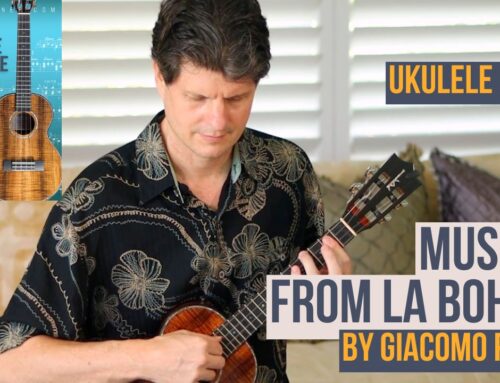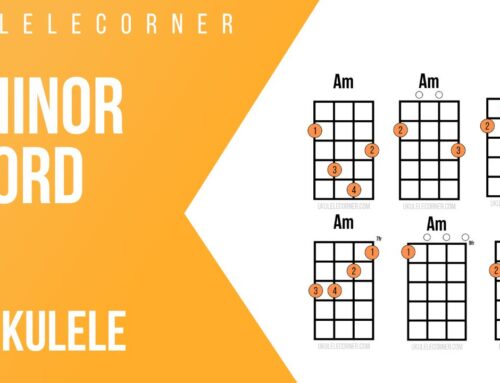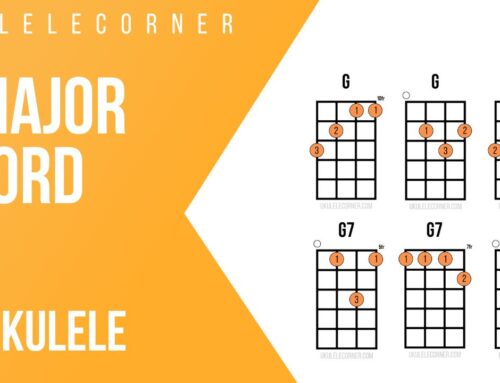In this post we’ll look at creating dynamics on ukulele.
Dynamics on Ukulele
Have you ever experimented with changing how loud or soft you play? These changes are often referred to as dynamics in music with the terms crescendo for an increase in volume and decrescendo for a decrease in volume. It can be challenging to effectively bring these changes out on the ukulele so let’s try some exercises to develop your dynamic range and control.
The Right Hand
Let’s start by simply playing the 1st string open. I suggest trying this with any right-hand fingering combination including using the thumb for all the notes and alternating between the index and middle fingers. It is good to practice this in many different ways so you can apply it to any fingering choice you make. If you alternate between the index and middle fingers, try planting your thumb on the 4th string to keep the hand steady.
Creating Dynamics on Ukulele
Try playing as softly as possible so the notes are almost inaudible. Not easy to do consistently while alternating, right? You may notice a note jumping out louder than the others from time to time. Practice this slowly with relaxation like a meditation and listen carefully to the sound you are making. It should just be a whisper. Now see if you can gradually increase the volume to a normal volume that you like to play at. The challenge here is to move steadily with incremental changes instead of suddenly getting loud. This creates smooth phrasing. Imagine the crescendo marking on sheet music and follow a smooth rise in volume for any intended length. I find a common issue is getting loud too quickly during a long crescendo.
Now continue to raise the volume until you are playing as loud as you can. You may not have tried this before. Really go for it until the note starts to distort. Every instrument has a limit to how loud you can play before the sound distorts. Get to know your ukulele and what is possible. Make sure you don’t pull up on the string if you are using free strokes. This will cause the string slap against the fingerboard and will sound thin. Sweeping your finger back towards the palm allows the string to vibrate without hitting the fingerboard. You can play much louder this way with a clean sound.
The Full Spectrum of Sound
Once you get to know the volume range of your instrument, try long rises and falls in dynamics and try to exaggerate the changes so you are using the full spectrum of sound. Becoming aware of this will open up new ways to express the music you play.
Try to apply this to a 1st position C scale or with songs you know well. You can also try sudden changes or what are often called “terraced dynamics.” Play a scale or phrase loud then suddenly soft when it repeats. Try applying this to contrast sections of songs you play. These concepts also apply well to strumming.
Dynamics and Phrasing
A typical 4- or 8-bar phrase can use a crescendo until about three-fourths of the way through and then can taper off with a decrescendo to give the phrase a smooth resolution. Try the 1st theme to Ode to Joy, which is the first piece in the Ukulele Corner Graded Repertoire for Classical Ukulele book.
First, play this as two 4-bar phrases with a larger arch and resolution the 2nd time. Now try it as a longer 8-bar phrase and build a very gradual crescendo until around the 6th bar with a 2-bar desrescendo to end the phrase with a nice soft cadence. Which do you prefer? As you experiment with dynamics and phrasing you will see that you have many great choices and there are often multiple ways to choose to shape phrases. I like the 8-bar idea and feel it is a good challenge to keep that nice steady rise then more rapid fall in volume. I find that thinking of music in this way brings out meaning and emotion and elevates the sound to a new level.
***
At Ukulele Corner Academy we explore a wide range of music and use dynamics to bring out expression and emotion. You will learn to shape phrases or add dynamic changes in specific ways to add meaning to the music you play. Join Ukulele Corner Academy today.




Can you choose one area of study. ie : dynamics or vibrato?